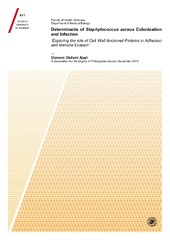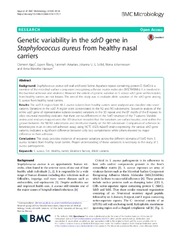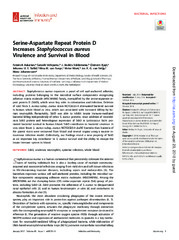| dc.contributor.advisor | Johannessen, Mona | |
| dc.contributor.author | Ajayi, Clement | |
| dc.date.accessioned | 2018-10-31T13:47:01Z | |
| dc.date.available | 2018-10-31T13:47:01Z | |
| dc.date.issued | 2018-11-09 | |
| dc.description.abstract | Staphylococcus aureus is an efficient human colonizer and pathogen. S.aureus' ability to colonize and/or cause infections in humans is due to its expression of many virulence factors. These virulence factors aid the bacterium in adhering, invading and evading the host´s immune defences. This study focused on exploring the role of two cell wall anchored proteins: Serine-aspartate containing protein D (SdrD) and S. aureus surface protein G (SasG) in S. aureus adhesion and/or immune evasion.
First, we identified Desmoglein 1 (Dsg1) as a host ligand for S. aureus SdrD. Desmogleins are part of the intercellular junctions that facilitate adhesion between the keratinocytes of the epidermis. We showed that the interaction between Dsg1 and SdrD is specific and dose-dependent. In addition, we showed that deletion of sdrD in S. aureus NCTC8325-4 attenuated the bacterial adhesion to Dsg1 expressing cells. Using Lactobacillus lactis expressing SdrD, we further confirmed that SdrD mediated bacterial adhesion to keratinocytes.
Furthermore, we showed genetic variability within A region sequences of the sdrD gene of S. aureus strains isolated from the anterior nares of healthy adults. We classified the sdrD variants into seven types and showed that the variations occurred within other regions of the SdrD protein. However, the N2-N3-B1 subdomains and R domain of SdrD have the most variations. The variations within the N2-N3-B1 subdomains were surface associated. Functional analyses using in vitro cell adhesion assay showed a significant difference between two of the sdrD variants.
In addition, we showed SasG promoted bacterial adhesion to human keratinocytes. In human blood, sasG expression was upregulated. Serum components induced early expression of SasG in a bacteriological medium. However, SasG did not promote the bacterial survival in an ex vivo human blood model but promoted bacterial aggregation when serum components were present.
Our findings show that both SdrD and SasG are involved in adhesion and that the mechanisms involved in S. aureus interaction with the host are complex. Additional studies are required to further understand the complete functions of these S. aureus virulence factors. | en_US |
| dc.description.doctoraltype | ph.d. | en_US |
| dc.description.popularabstract | Staphylococcus aureus is responsible for many human infections ranging from mild to life-threatening diseases. Challenges with S. aureus have been further worsened by its antibiotic resistance development. There is a need to focus on alternative strategies for fighting S. aureus diseases. S. aureus produces molecules that act like weapons that help it to survive or cause disease in humans. One strategy of fighting S. aureus disease is to disarm the bacteria, thereby reducing its ability to cause disease. This requires a deep understanding of how the bacterial proteins (“weapon”) works and causes diseases. This work aimed to understand the function of two of the bacterial protein.
In this study, we found that S. aureus protein called serine-aspartate containing protein D (SdrD) can act as “glow” and increase the bacteria’s ability to bind to human skin cells. However, there are some variations within the sequences of S. aureus SdrD, which might influence this function, suggesting that not all strains have the same ability to bind to the same skin cell type. We also studied another bacterial “weapon” called S. aureus surface protein G (SasG). This protein can also help the bacteria to bind to skin cells. In total, we have looked at two proteins that bacteria can use as “weapon” in order to establish itself in the host. Our findings will contribute to understanding S. aureus interaction with humans and help in the development of alternative therapeutic strategies. | en_US |
| dc.description.sponsorship | This work has been carried out in the Research Group of Host-Microbe Interactions, Faculty of Medical
Biology, UiT, the Arctic University of Norway. This work was supported by grants from The Northern Norway Regional Health Authority (Helse Nord RHF), Miljøstøtte MIL963–10 (2010–2012) and Infection Biology and Antimicrobials (IBA) research school (NFR project number 249062). | en_US |
| dc.identifier.uri | https://hdl.handle.net/10037/14070 | |
| dc.language.iso | eng | en_US |
| dc.publisher | UiT The Arctic University of Norway | en_US |
| dc.publisher | UiT Norges arktiske universitet | en_US |
| dc.relation.haspart | <p>Paper I: Askarian, F., Ajayi, C., Hanssen, A.M., van Sorge, N.M., Pettersen, I., Diep, D.B., … Johannessen, M. (2016). The interaction between <i>Staphylococcus aureus</i> SdrD and desmoglein 1 is important for adhesion to host cells. <i>Scientific Reports, 6</i>, 22134. Also available at <a href=http://hdl.handle.net/10037/9518>http://hdl.handle.net/10037/9518.</a><p>
<p>Paper II: Ajayi, C., Åberg, E., Askarian, F., Sollid, J.U.E., Johannessen, M. & Hanssen, A.M. (2018). Genetic variability in the <i>sdrD</i> gene in <i>Staphylococcus aureus</i> from healthy nasal carriers. <i>BMC Microbiology, 18</i>(34). Also available at <a href=http://hdl.handle.net/10037/14031>http://hdl.handle.net/10037/14031. </a><p>
<p>Paper III: Ajayi, C., Geoghegan, J., Askarian, F. & Johannessen, M. Expression and Virulence properties of <i>Staphylococcus aureus</i> MSSA476 Surface protein G (SasG). (Manuscript). Full text not available in Munin. <p><p><p>
<p>Appendix:<p>
<p>Askarian, F., Uchiyama, S., Valderrama, J.A., Ajayi, C., Sollid, J.U.E., van Sorge, N.M., … Johannessen, M. (2017). Serine-aspartate repeat protein D increases <i>Staphylococcus aureus</i> virulence and survival in blood. <i>Infection and Immunity, 85</i>, e00559-16. Also available at <a href=http://hdl.handle.net/10037/10604>http://hdl.handle.net/10037/10604</a><p> | en_US |
| dc.rights.accessRights | openAccess | en_US |
| dc.rights.holder | Copyright 2018 The Author(s) | |
| dc.rights.uri | https://creativecommons.org/licenses/by-nc-sa/3.0 | en_US |
| dc.rights | Attribution-NonCommercial-ShareAlike 3.0 Unported (CC BY-NC-SA 3.0) | en_US |
| dc.subject | VDP::Medical disciplines: 700::Basic medical, dental and veterinary science disciplines: 710::Medical microbiology: 715 | en_US |
| dc.subject | VDP::Medisinske Fag: 700::Basale medisinske, odontologiske og veterinærmedisinske fag: 710::Medisinsk mikrobiologi: 715 | en_US |
| dc.subject | VDP::Mathematics and natural science: 400::Basic biosciences: 470::Molecular biology: 473 | en_US |
| dc.subject | VDP::Matematikk og Naturvitenskap: 400::Basale biofag: 470::Molekylærbiologi: 473 | en_US |
| dc.subject | VDP::Medical disciplines: 700::Basic medical, dental and veterinary science disciplines: 710::Medical molecular biology: 711 | en_US |
| dc.subject | VDP::Medisinske Fag: 700::Basale medisinske, odontologiske og veterinærmedisinske fag: 710::Medisinsk molekylærbiologi: 711 | en_US |
| dc.subject | VDP::Mathematics and natural science: 400::Basic biosciences: 470::Bioinformatics: 475 | en_US |
| dc.subject | VDP::Matematikk og Naturvitenskap: 400::Basale biofag: 470::Bioinformatikk: 475 | en_US |
| dc.subject | VDP::Mathematics and natural science: 400::Basic biosciences: 470::General microbiology: 472 | en_US |
| dc.subject | VDP::Matematikk og Naturvitenskap: 400::Basale biofag: 470::Generell mikrobiologi: 472 | en_US |
| dc.subject | VDP::Medical disciplines: 700::Basic medical, dental and veterinary science disciplines: 710::Medical microbiology: 715 | en_US |
| dc.subject | VDP::Medisinske Fag: 700::Basale medisinske, odontologiske og veterinærmedisinske fag: 710::Medisinsk mikrobiologi: 715 | en_US |
| dc.title | Determinants of Staphylococcus aureus Colonization and Infection.
“Exploring the Role of Cell Wall Anchored Proteins in Adhesion and Immune Evasion” | en_US |
| dc.type | Doctoral thesis | en_US |
| dc.type | Doktorgradsavhandling | en_US |


 English
English norsk
norsk






